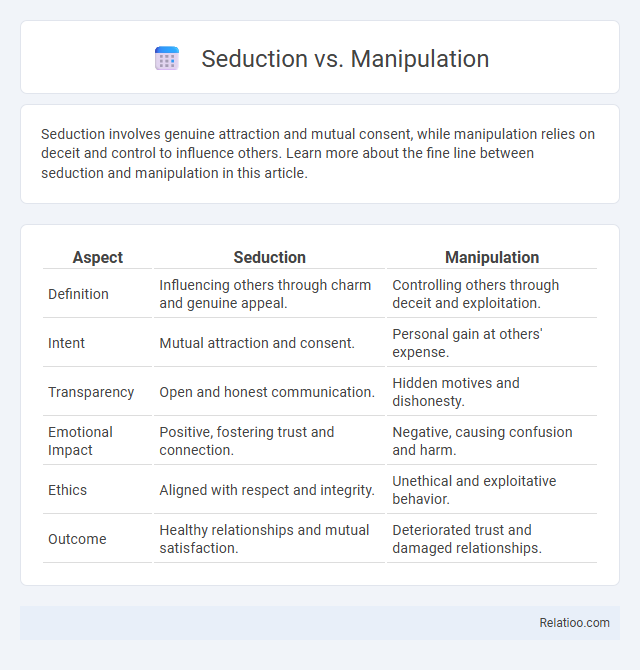Seduction involves genuine attraction and mutual consent, while manipulation relies on deceit and control to influence others. Learn more about the fine line between seduction and manipulation in this article.
Table of Comparison
| Aspect | Seduction | Manipulation |
|---|---|---|
| Definition | Influencing others through charm and genuine appeal. | Controlling others through deceit and exploitation. |
| Intent | Mutual attraction and consent. | Personal gain at others' expense. |
| Transparency | Open and honest communication. | Hidden motives and dishonesty. |
| Emotional Impact | Positive, fostering trust and connection. | Negative, causing confusion and harm. |
| Ethics | Aligned with respect and integrity. | Unethical and exploitative behavior. |
| Outcome | Healthy relationships and mutual satisfaction. | Deteriorated trust and damaged relationships. |
Understanding Seduction and Manipulation
Seduction involves influencing someone's emotions and desires through charm and attraction, fostering genuine connection and mutual consent. Manipulation, in contrast, exploits psychological tactics to control or deceive others for personal gain, often disregarding their well-being. Understanding these differences helps Your interactions remain ethical and respectful, distinguishing between influence based on trust and coercion driven by selfish motives.
Key Differences Between Seduction and Manipulation
Seduction involves creating attraction and desire through charm and appeal, fostering genuine emotional connection, whereas manipulation exploits deceit and control to achieve selfish goals at the expense of others. Seduction relies on mutual consent and often aims for relational intimacy, while manipulation disregards consent and focuses on coercion or misleading tactics. The key difference lies in intent and ethical boundaries: seduction seeks engagement and allure, manipulation prioritizes dominance and personal gain.
Psychological Principles Behind Seduction
Seduction leverages psychological principles such as reciprocity, social proof, and emotional connection to create genuine attraction, unlike manipulation, which relies on deceit and exploitation of weaknesses. Techniques like mirroring body language and active listening foster trust and intimacy, making seduction an art of influence based on authenticity. Understanding these distinctions helps you navigate relationships with ethical awareness and emotional intelligence.
The Tactics of Manipulation Explained
Manipulation tactics exploit psychological vulnerabilities by using guilt, fear, or deception to control others covertly, differentiating it from seduction, which relies on attraction and consent. Techniques such as gaslighting, emotional blackmail, and strategic misinformation erode trust and autonomy, causing victims to doubt their perceptions. Understanding these manipulative strategies is crucial for recognizing and resisting exploitative behaviors in personal and professional relationships.
Consent and Ethics: Seduction vs Manipulation
Seduction involves consensual attraction where both parties willingly engage, emphasizing mutual consent and ethical interaction. Manipulation bypasses genuine agreement by using deceit or coercion, violating personal autonomy and ethical boundaries. Distinguishing seduction from manipulation hinges on respecting consent and maintaining transparent, honest communication.
Emotional Impact on Individuals
Seduction influences individuals by appealing to their desires and creating a sense of attraction, fostering positive emotional engagement and voluntary participation. Manipulation, in contrast, exploits emotions like fear or guilt, often leading to confusion, mistrust, and emotional distress. Both tactics affect emotional responses but differ fundamentally in intent, with seduction aiming for mutual benefit, whereas manipulation prioritizes control and self-interest.
Signs of Healthy Seduction
Healthy seduction involves mutual respect, clear communication, and genuine attraction without hidden agendas or coercion. Signs include open consent, emotional honesty, and the presence of enthusiasm from both parties, differentiating it from manipulation, which relies on deceit and control. Your ability to recognize these boundaries ensures relationships built on trust and authenticity.
Recognizing Manipulative Behavior
Recognizing manipulative behavior involves identifying tactics that exploit your emotions and undermine your autonomy, such as guilt-tripping, gaslighting, or persistent pressure. Seduction relies on genuine attraction and consent, while manipulation covertly controls and deceives for personal gain. Understanding these distinctions helps you protect your boundaries and make empowered decisions in interpersonal relationships.
How to Protect Yourself from Manipulation
Protecting yourself from manipulation requires recognizing tactics like emotional exploitation, deceit, and coercion commonly used to influence decisions unfairly. Establishing clear personal boundaries and trusting your intuition helps prevent manipulation by maintaining control over your choices and emotions. Developing assertiveness and seeking objective perspectives from trusted individuals further strengthens your ability to identify and resist manipulative behaviors.
Building Respectful and Authentic Connections
Seduction, manipulation, and influence differ significantly in intent and impact, with seduction aiming to attract through genuine charm and confidence, while manipulation exploits others for personal gain without regard for their feelings. Building respectful and authentic connections requires prioritizing honesty, empathy, and clear communication, fostering trust and mutual respect in your relationships. Your ability to distinguish these behaviors ensures healthier interactions and promotes lasting bonds rooted in integrity.

Infographic: Seduction vs Manipulation
 relatioo.com
relatioo.com